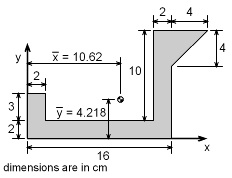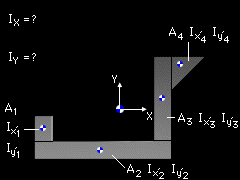| Ch 7. Centroid/Distributed Loads/Inertia | Multimedia Engineering Statics | ||||||
|
Centroid: Line Area Vol |
Centroid: Composite | Distributed Loads | Area Moment of Inertia | ||||
| Area Moment of Inertia | Case Intro | Theory | Case Solution | Example |
| Chapter |
| 1. Basics |
| 2. Vectors |
| 3. Forces |
| 4. Moments |
| 5. Rigid Bodies |
| 6. Structures |
| 7. Centroids/Inertia |
| 8. Internal Loads |
| 9. Friction |
| 10. Work & Energy |
| Appendix |
| Basic Math |
| Units |
| Sections |
| eBooks |
| Dynamics |
| Fluids |
| Math |
| Mechanics |
| Statics |
| Thermodynamics |
| ©Kurt Gramoll |
|
|
||||||||||||||||||||
| Composite Parts - Moments of Inertia |
||||||||||||||||||||
 Dimension Diagram
|
After breaking the cross section into its composite parts, determine the area, the location of the centroid, and the centroidal moments of inertia for each part. The centroid and the area of each part were found in the previous section, Centroid: Composite Parts. The moments of inertia for each part can be found from the tables in the Sections Appendix. For the axis system as shown, the properties for part 1 are, x1 = 1 cm y1 = 3.5 cm A1 = 6 cm2 Ix'1 = 1/12 2(3)3 = 54/12 cm4 Iy'1 = 1/12 3(2)3 = 24/12 cm4 The properties for part 2 are, x2 = 8 cm y2 = 1 cm A2 = 32 cm2 Ix'2 = 1/12 16(2)3 = 128/12 cm4 Iy'2 = 1/12 2(16)3 = 8192/12 cm4 And the properties for part 3 are, x3 = 15 cm y3 = 7 cm A3 = 20 cm2 Ix'3 = 1/12 2(10)3 = 2000/12 cm4 Iy'3 = 1/12 10(2)3 = 80/12 cm4 Part 4 is a triangle and its properties are, x4 = 17.33 cm y4 = 10.67 cm A4 = 8cm2 Ix'4 = 1/36 4(4)3 = 256/36 cm4 Iy'4 = 1/36 4(4)3 = 256/36 cm4 |
|||||||||||||||||||
 Distances from Global Centroid |
These can be used with the following equations to find the moments of inertia of the entire cross section with respect to the centroid of the cross section. Here dxi and dyi are the distances from the centroid of the cross section (global centroid) to the centroid of any part i. These distances are given by the equations: |
|||||||||||||||||||
(from Centroid: Composite Parts) |
Substituting x, y and the results of the above equations give, dx1 = 10.616 - 1 = 9.616 cm dx2 = 10.616 - 1 = 2.616 cm dx3 = 10.616 - 15 = -4.384
cm dx4 = 10.616 - 17.33 = -6.714
cm Substituting each dxi, dyi, Ix'i, and Iy'i into the basic summation equations give Ix = 1,011 cm4 Iy = 2,217 cm4 In the theory page, the polar moment of inertia was show to be equal to Jz = Ix + Iy Substituting for Ix and Iy gives the polar moment, Jz = 3,228 cm4 Since this is not a symmetrical cross section, the product of inertia, Ixy is not zero. The produce of inertia is used for un-symmetrical bending which is not covered in this statics eBook. |
|||||||||||||||||||
Practice Homework and Test problems now available in the 'Eng Statics' mobile app
Includes over 500 free problems with complete detailed solutions.
Available at the Google Play Store and Apple App Store.

